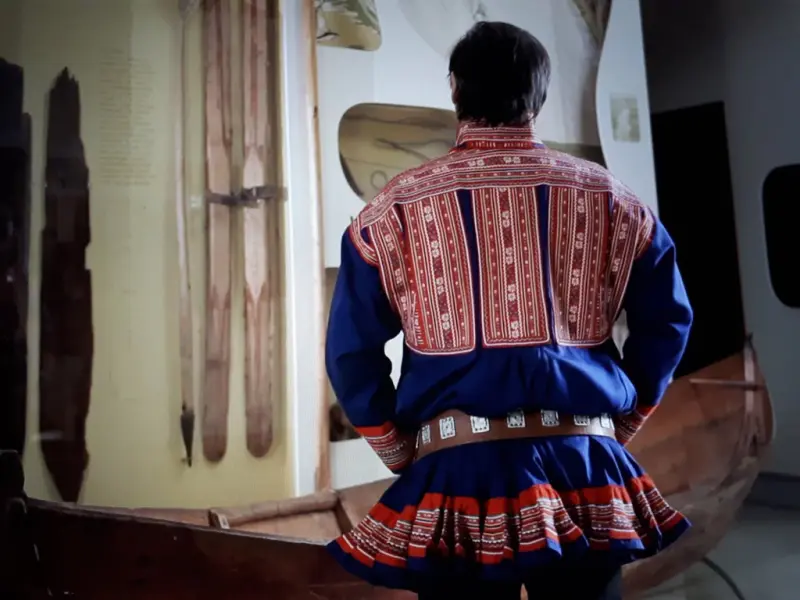
The Expanded Photograph
Archives for tangible and intangible Sámi heritage
How to read photographs? How much information should be added to the thousands of photos that we keep in our museum archives? This is a picture of a Sámi man, seen from the rear, dressed in a Northern Sámi gákti from Guovdageaidnu. Precise entries in the photographic database might well be: “Man”, “Sámi outfit”, “Exhibition Samekulturen”. Sometimes this is all we find in museum photo-databases. Looking carefully, he stands firmly in the hall of a historical exhibition: Samekulturen at the Arctic University Museum in Tromsø.
Therefore, a rhetorical question: are these entries adequate in order to approach this photo? Obviously not, hence research about the archive should contribute, through a critical gaze, to expand on the significance and interpretation, the historical dimensions and readings of images. Another level in this critical work, is to interconnect various pictures not only with relevant information, but also analytically, referring to the context in which the images were used, appropriated, manipulated, forgotten.
Someone may recognize the person in the picture just by looking at his posture. For those who recognize this body language at the first sight, this person is Ole Henrik Magga, the first President of the Sámi Parliament of Norway (1989-1997) who became Chair of the Forum for Indigenous People at the UN in 2002. This picture is dated 2014. He stands in the venue where he, some 45 years earlier, was acting as scientific assistant of Prof. Ørnulf Vorren (1916-2007), studying the exhibition’s contents in order to disseminate knowledge about Sámi culture at the pedagogical level. Later, Magga became professor of linguistics at the Arctic University of Norway.
What the picture does not tell us, is that he is chanting a joik at the moment when the photo was taken. Joik is a musical and lyrical form chanted by the Sámi people, its genesis is very ancient. Persons, animals, landscapes, and experiences can all be the subject in a joik. The one here performed is “The Spirit from the Nine Valleys”, a piece dear to Magga. He chants about a sieidi in the north of Troms, protecting animals, plants, human beings. According to him, it is probably one of the oldest joik that are known today.
The recording is part of the collections of Sámi traditional music at the museum, systematized and expanded by Ola Graff. In the museum collections, performance and cultural heritage intersect. Recording and inscriptions produce new forms of material culture. Any photo, and hence this very photo, is soundless. However, knowing that its subject was singing at the moment of the shooting, may enhance the desire to consult the music archive of the University Museum and listen to this rarely chanted joik. The joik: From minute 11.25. Performed by Ole Henrik Magga in 2014. This same joik was recorded by Ragnvald Graff in 1958, chanted by Anders Johansen Eira.
Viiddiduvvon govva
Vuorká matriála ja vuoiŋŋalaš sámi árbi
Movt mon logan govaid? Man ollu dieđu galgá laktadit daidda duháhiid mielde govaide maid mii vurkkodit min museavuorkkáin? Dát lea govva sámi dievdoolbmos, gehččon duogábealde, sus lea davvisámi gákti Guovdageainnus. Dárkilis gilkorat dán govalaš dáhtávuorkái sáhttet leat: ”Dievdoolmmoš”, “Sámi outfit”, ” Čájáhus”, ”Sámi kultuvra”. Muhtimin leat dát visot maid gávnnat musea govvadáhtavuorkkás. Jus geahččá dárkilit de son čuožžu historjjálaš čájáhuslanjas ”Sámekultuvvra” čájáhusas, Norgga árktalaš universitehtamuseas, Romssas.
Danne lea retorihkalaš gažaldat: leat go dát gilkorat doarvái go áigu lahkanit dán govvii? Nu ii oro leahkime, danne galggašii dutkan vuorkká birra kritihkalaš geahččama bokte buktit oasi dan mearkkašupmái ja dulkomii, historjjálaš dimenšuvnnaide ja movt govaid dulko. Nubbe dássi dán kritihkalaš barggus lea čatnat govaid oktii, ii dušše relevánta dieđuiguin muhto maiddái analyhtalaččat, ja čujuhit dan oktavuhtii go govat geavahuvvoje, juhkkojuvvoje, rievdaduvvoje, vajálduvvu.
Soamis soaitá dovdat olbmá go dušše oaidná su fárdda. Son guhte lea oahpis dakkár rumašgillii dovdá dakkaviđe ahte olmmoš lea Ole Henrik Magga, Norgga sámedikki vuosttáš presideanta (1989-1997), son šattai eamiálbmogiid foruma ságadoalli ON:as 2002. Dát govva lea jagi 2014 rájis. Son lea dan báikkis, nuo 45 jagi maŋŋá barggai dieđalaš veahkkin professor Ørnulf Vorrenii (1916-2007) ja son dutkkai čájáhusa sisdoalu ja dasto juogadii dieđuid sámi kultuvrra birra pedagogalaš dásis.
Mii ii oidno govas lea dat ahte go son govvejuvvui son juoiggai. Luohti lea musihkalaš ja lyralaš ovdanbuktin mii lea vierru sámiin, don doloža rájis. Olbmot, ealiba, duovdagat ja vásáhusat máhttet juigojuvvot. Dát mii gullo lea ”Ovcci vákki vuoiŋŋa”, luohti mii lea ráhkis Maggai. Son juoigá sieiddi Davviromssas. Dat suddje ealibiid, šattuid, olbmuid. Son dadjá dát lea okta dain boarráseamos dovddus luđiin odne.
Bádden lea oassi čoakkáldagas sámi árbevirolaš musihkas museas, systematiserejuvvon ja lasihuvvon Ola Graffas. Musea vuorkkás bohtet čájálmas ja kulturárbi oktii. Báddemat ja inskripšuvnnat addet ođđa hámi materiálakultuvrii. Juohke govas, ja danne maid dán govas, váilo jietna. Go diehtá dát objeakta juoiggai filbmedettiin sáhttá buktit miela mannat Universitehtamusea jietnavuorkái ja guldalit dán hárve gullon luođi.
Luohti: minuhtta 11.25 rájis . Ole Henrik Magga juoiggai dan 2014. Seammá luohti báddejuvvui Ragnvald Graffas jagi 1958, juoigi lea Anders Johansen Eira.
Teavsttat leat jorgaluvvon dávvesámegillii girječálli John Erling Utsis ja Camilla Brattland, Norgga árktalaš universiteahttamusea, lea divvon daid.